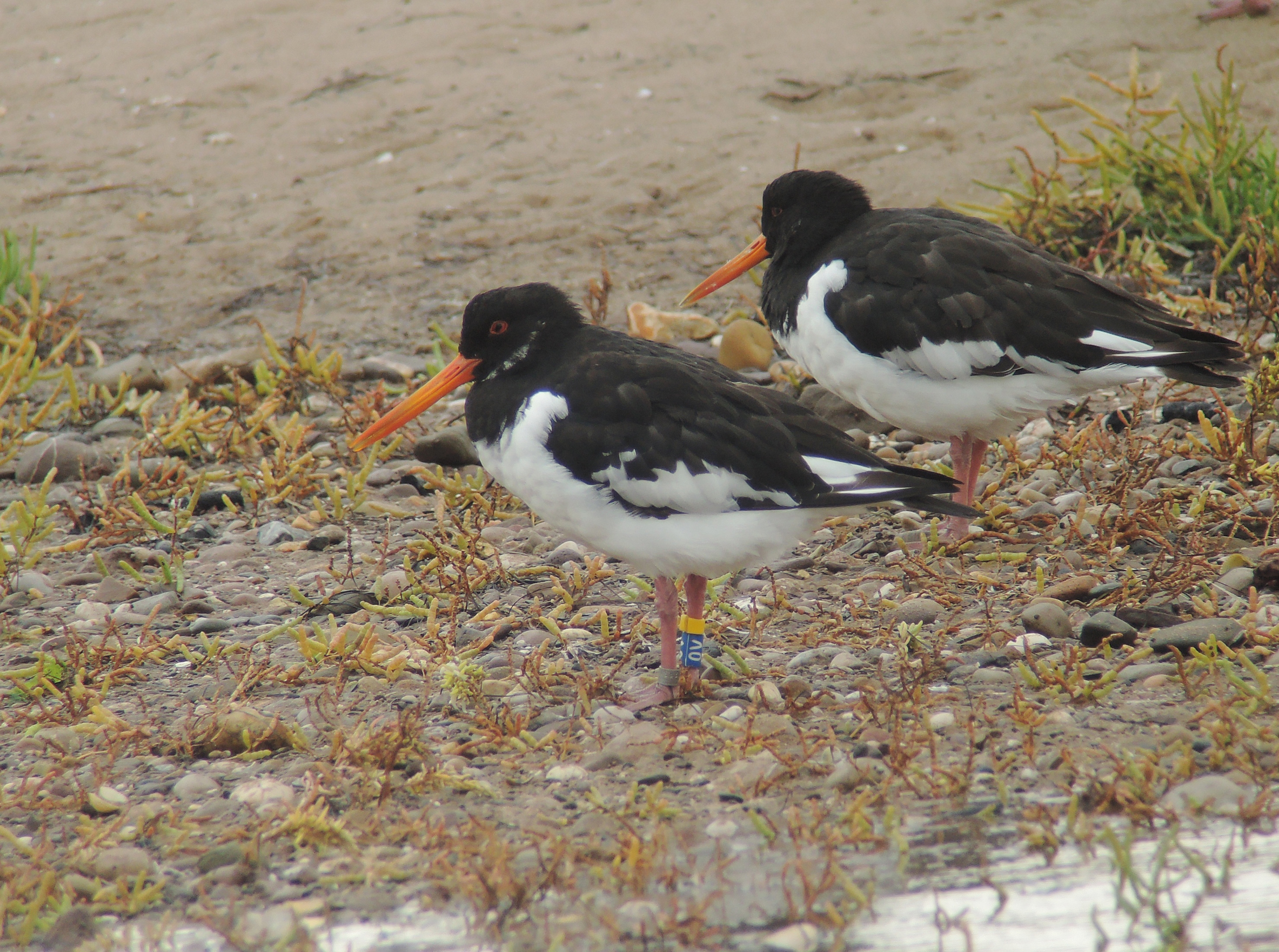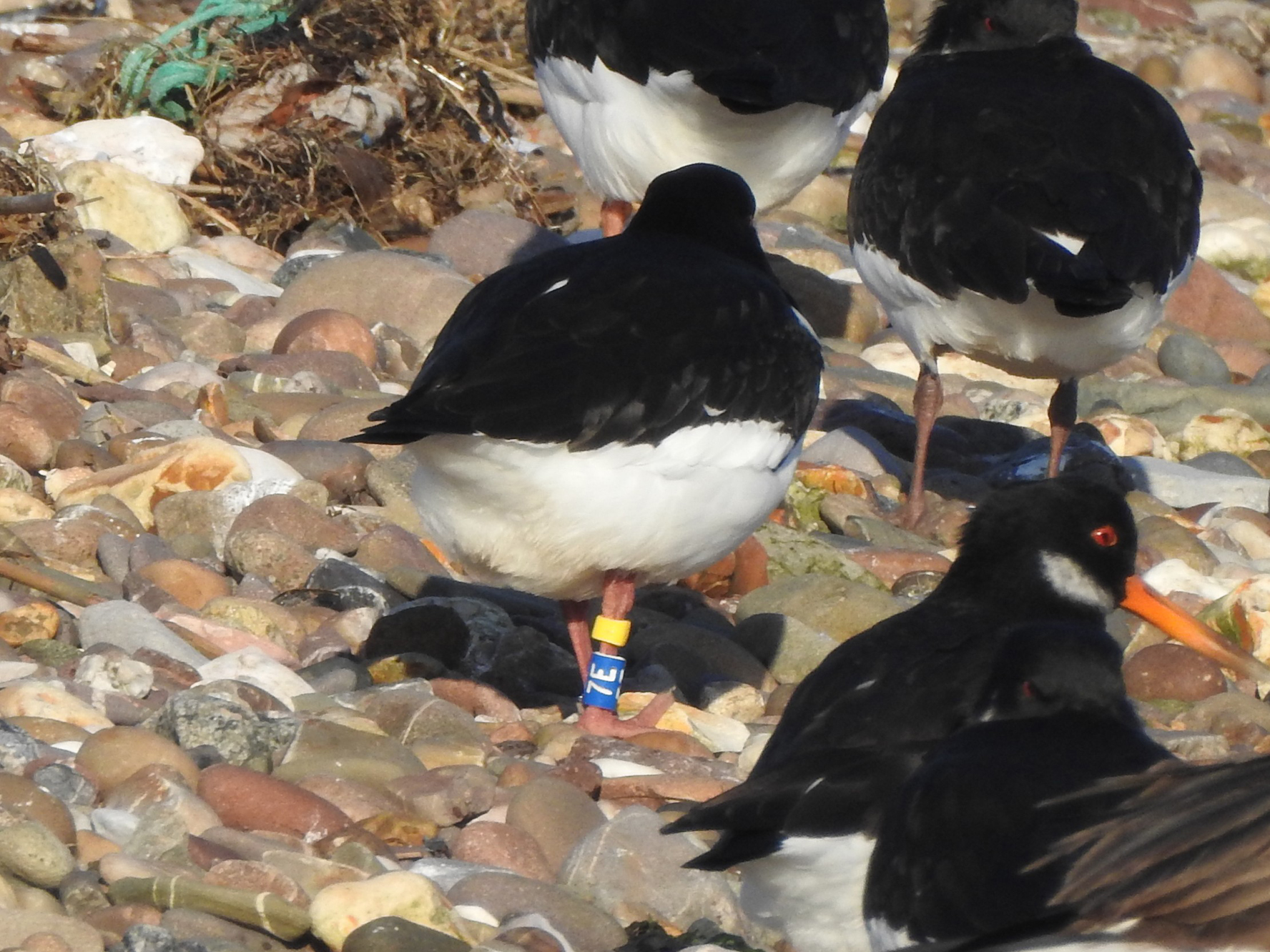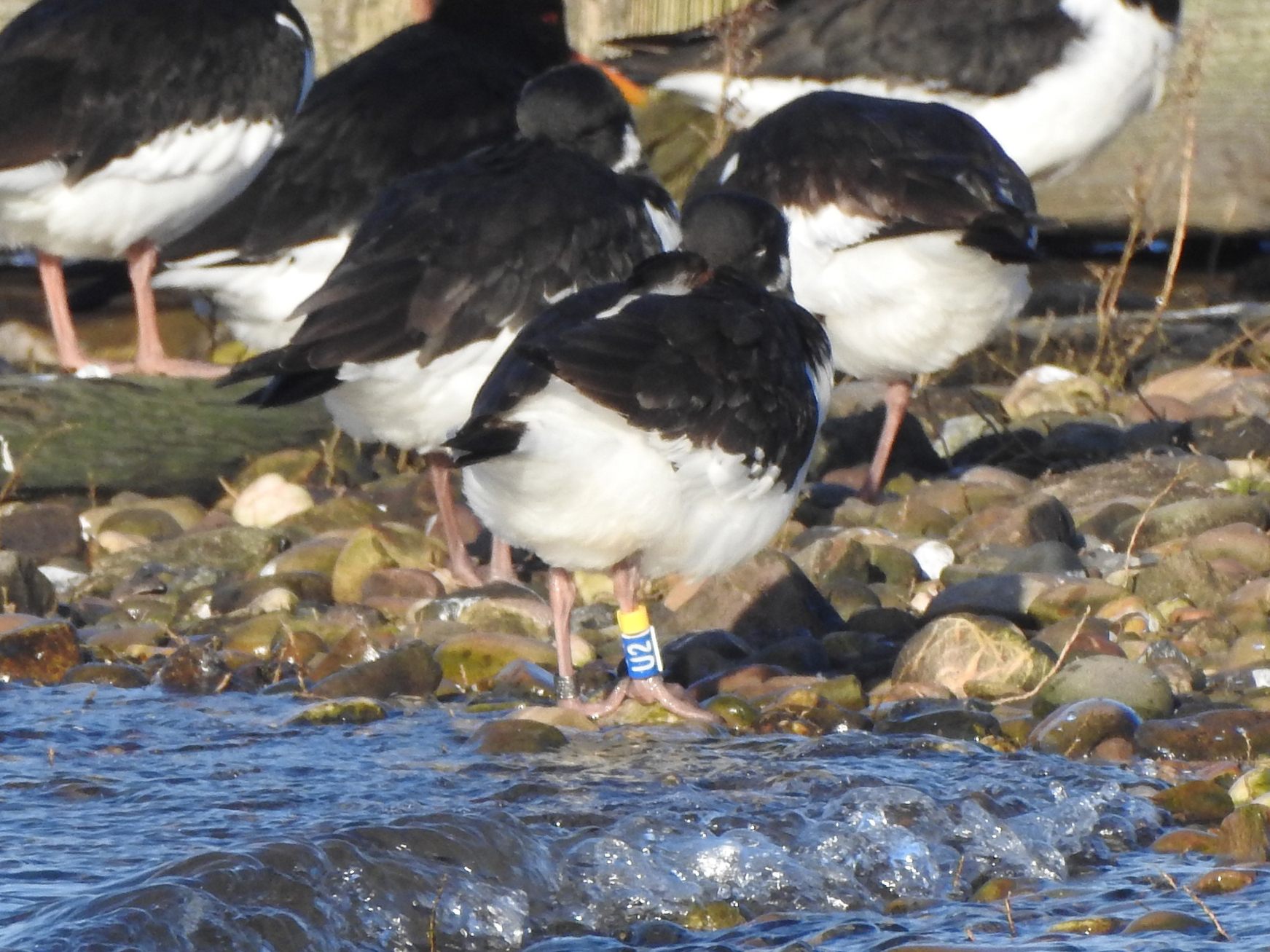Exe Estuary Oystercatcher Project
June 2020
Update
Please submit sightings of colour-ringed oystercatchers to
exeoystercatchers@gmail.com
with details of the location, date, flock size and what it was doing. The
code on the big blue ring reads bottom up; most are alphanumeric and a few are
double-letter coded. Thank you.

OV
Since Feb 2018, the number of Oystercatcher colour-ringed at Dawlish Warren to date is 272, plus another 42 with just a standard BTO metal ring fitted.
Excluding first capture dates, at the close of May 2020 there have been 4,501 re-sightings and re-trappings of these colour-ringed Oystercatchers. As the region’s most important roost site for this species and where the project is based, it is not surprising that the vast majority (3,983 or 88.5%) of these have been at Dawlish Warren NNR. The bird hide has been essential for this field research. Tribute is here given to the dedication and patience of all field observers who report sightings of these birds, invaluable ‘citizen science’ contributions that research relies. The project’s aims are to improve and update our knowledge about the habits of these iconic birds, and to collate evidence about reasons why their population has declined on the Exe Estuary over many years. Special mention is given to Lee Collins, arguably one of the country’s most prolific ‘ring readers’, who has been involved in amassing an astonishing 2,838 (71.3%) of these Dawlish Warren re-sightings, an average of more than 3 birds every day! These together with other members of the Dawlish Warren Recording Group, account for 96.4% of these re-sightings.
Oystercatchers disperse throughout and around beyond the edges of the Exe Estuary to forage and rest, with concentrations of birds at richer sources of prey. To date an additional 457 re-sightings have been received from elsewhere around the wider estuary. Particular thanks is given to Exeter University students and supervisors, particularly Jo Morten for collating most of these sightings that provide important details about some individual birds that prefer to disperse and remain on other parts of the Exe Estuary for the winter, away from Dawlish Warren and after the autumn aggregation period there.
Popular locations for these Oystercatchers are Eastdon Fields, Oak Meadow Golf Course at Starcross, Cockle Sands and the Duck Pond near Exmouth, and The Ridge in the middle of the estuary out from Lympstone.
Five sightings of three individuals on the Teign Estuary, foraging on the Salty near the Teignmouth to Shaldon Bridge demonstrates the anticipated link between these two estuaries and their use by Oystercatcher. Thanks to Steven O'Donoghue for reporting these sightings.
| Info burst (‘FLL’): the value of re-sightings extends beyond the purely academic and they can be used, for example, to support considerations within a legal context. The Exe Estuary is a European Site with designations that include it as a Special Protection Area (SPA). Its non-breeding population of Oystercatcher is one of the reasons for this designation; such species are called ‘qualifying features’. To survive, this species may rely on places that lie beyond the designed boundary and if these places support significant numbers can be regarded as Functionally Linked Land (FLL). This has legal implications for plans or projects, such as housing development proposals that might otherwise adversely affect the integrity of the SPA by virtue of impacting on these Oystercatchers. Re-sightings of individual birds can build up a body of evidence about places that are potentially FLL and to directly link those places to the Exe Estuary SPA. |
The Exe Estuary and Teign Estuary account for 4,445 of the 4,501 re-sightings, leaving 56 outside of the county that have involved 31 individual colour-ringed birds. Some fantastic stories lie behind these basic figures and although only two full summers and two full winters have passed since since the project re-commenced in Feb 2018, the project has reaffirmed established thinking about some aspects of their distribution and habits, but has revealed some real surprises too.
Fidelity shown by this species to return each winter to its wintering site, in our case the Exe Estuary, is well known and some individuals have done this for literally decades. Clues are also emerging about their faithfulness to breeding sites. ‘1M’ returned to Lochindorb in Highland, Scotland in 2018 & 2019; ‘4M’ returned Bømlo in Norway in 2018, 2019 & 2020 (thanks to Lars Økland for reporting that bird); ‘5J’ returned to the same part of Bedfordshire in 2018 & 2019; ‘7U’ to Isle of Islay, Scotland in 2019 & 2020 (thanks Val and Mike Peacock); ‘8K’ to Ölfus and Eyrarbakki on the southwest coast of Iceland. The project’s first Oystercatcher to be reported from beyond the estuary, ‘M7’ returned to Carsington Water, Derbyshire in 2018, 2019 & 2020 (thanks Clive Ashton and Roger Carrington). And ‘X3’ was seen at Zandmotor, Ockenburgh in the Netherlands in 2019 & 2020.
These sightings also suggest something about migration timings. The Carsington Water bird (300 km away from Dawlish Warren) gets first reported on breeding grounds in early-February (earliest on 1st), but despite the slightly lower latitude and shorter journey (270 km), the Bedfordshire bird was first reported in consecutive springs rather later, in mid- to late-Mar.
 |
 |
Even just single sightings can offer immeasurable value to a project, as demonstrated by the reporting of ‘H7’ at Larne Harbour, Co. Antrim on 17 Feb 2019, 500 km away to the NNW, less than 24 hours after it was seen at Dawlish Warren. However, deriving possible patterns (such as timings summarised above) based on only a few sightings is tantalising but not always reliably robust. The project uses a number of tools to build on its collation of data for later analysis, and one of those is GPS tags.
Of the 272 Oystercatcher fitted with colour-ringed, 20 of these were also fitted with a GPS devices. The device is harmless and attached to the back with a harness fitted by a licensed and specially trained ringer. The device model used is designed for longevity and can be set to take readings at different intervals at different seasons. Results reveal the habits of individual tracked birds as favouring particular locations on the estuary and down the coast to Dawlish seafront to forage. More about this part of project will be shared in future.
| Info burst (survival): although a bit basic and without the
use of clever software, return re-sighting rates can be used to infer
something about survival by looking at tranches of colour-ringed birds,
such as the 150 Oystercatcher colour-ringed in Feb 2018 and the 69
ringed in late-Sep to mid-Nov 2018. Across all ages, the overall annual
rate is approximately 85-90%, which compares to published figures (see
BTO BirdFacts). Body weight is highly indicative of the health of birds. The average weight of all birds caught late-Sep to mid-Nov is 514 grams (n=122), but those caught in Feb were more than 12% heavier, on average, 579 grams (n=190) and this difference was statistically significant (as shown by results of a ‘z-test’. This suggests that birds arriving at lighter weights, after their autumn migration to the Exe are able to forage over the winter period to gain reasonable weight ahead of their spring migration (an average weight for an adult is 546 grams). With re-sightings’ rates closely resembling survival rates and with significant weight gain at the end of the winter, these results reveal no obvious initial short-term clues as to the causes of the population decline. Research continues into looking at various theories. |
Summer 2020 will be the third summer since the project to colour-ringed Oystercatcher here re-started in Feb 2018. A long-lived species, it typically reaches maturity at about 4 years old. Smaller numbers of Oystercatcher are present on the Exe Estuary throughout the spring and summer, and postulated from plumage details, this flock appears to comprise of mostly non-breeding immature birds. Colour-ringed birds support that theory. Of the 26 that over-summered in 2018 (17.3%), only one was considered to be a full adult when ringed earlier that Feb. About 18 of those birds remained into spring 2019 and five of those have so far also been seen into spring 2020, demonstrating that a fair proportion of Oystercatchers seen from summer to summer, as well as winter to winter, are the same individuals.
Of the 69 colour-ringed in autumn/ early-winter 2018, nine summered in 2019 (13.0%) and all of those were immature birds. Notwithstanding the relatively small samples, the slightly higher percentage given in 2018 compared to 2019 can assume to be accounted for by birds that perished in the winter between being ringed and the following summer. There are many ways to analyse and present results, but again, this all relies on the good will and skill of people out in the field. Keep up the good work.
A big thank you to all the observers in Britain and throughout Europe who’ve
reported sightings so far. Thanks also to Dawlish Warren Golf Course, Devon
Wildlife Trust and Teignbridge District Council for their
continued assistance and support for the project.
As you scan through the Oystercatchers at
Dawlish Warren, or elsewhere, for the distinct blue-coloured rings, you may also
notice individuals from previous Exe studies, still sporting worn out ‘wasp
rings’, in addition birds colour-ringed in Scotland, Wales and Iceland have also
been recorded.
Posted on behalf of the Exe Oystercatcher project team.
Please send details of sightings of colour-ringed oystercatchers to: -
Thank you!
Text provided by Ivan Lakin. Pictures - Lee Collins (top) & Alan Keatley (lower two)